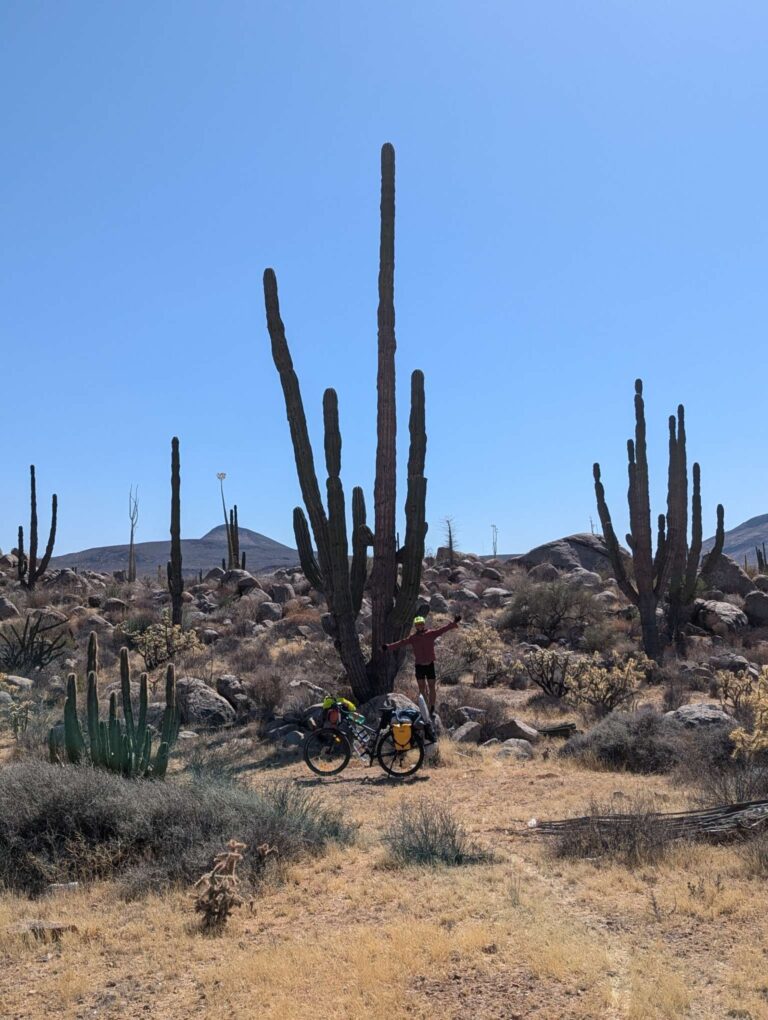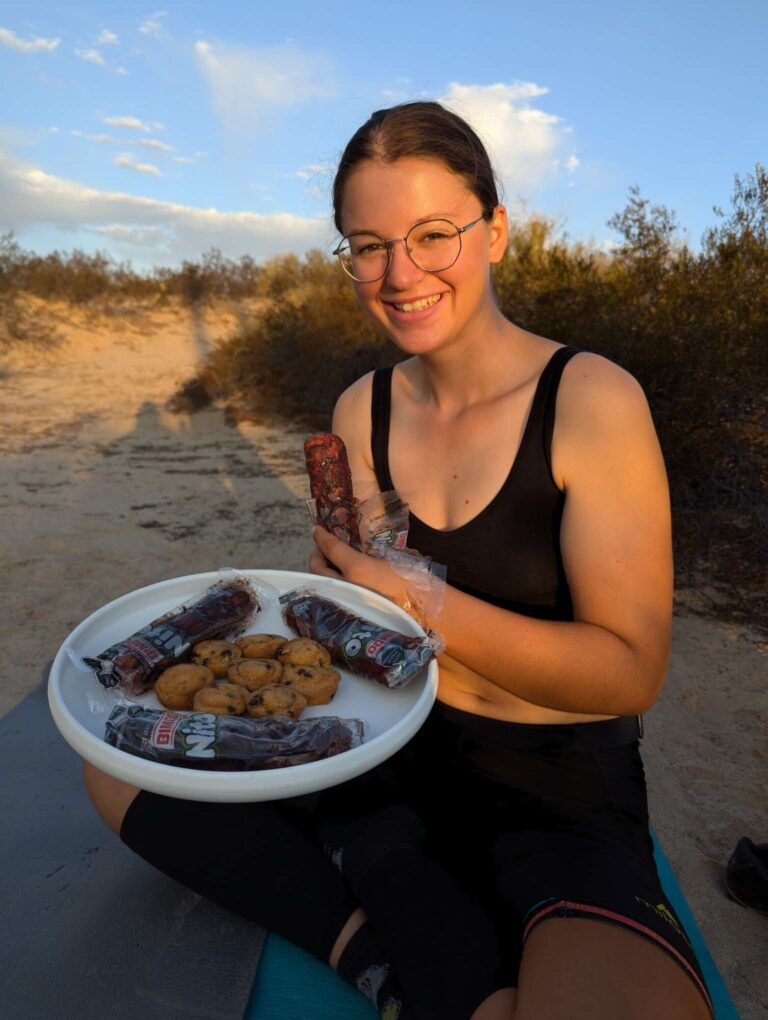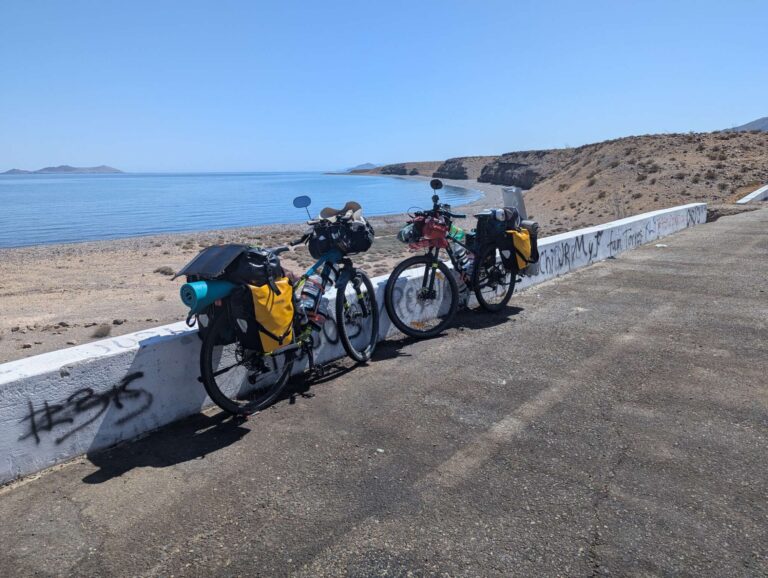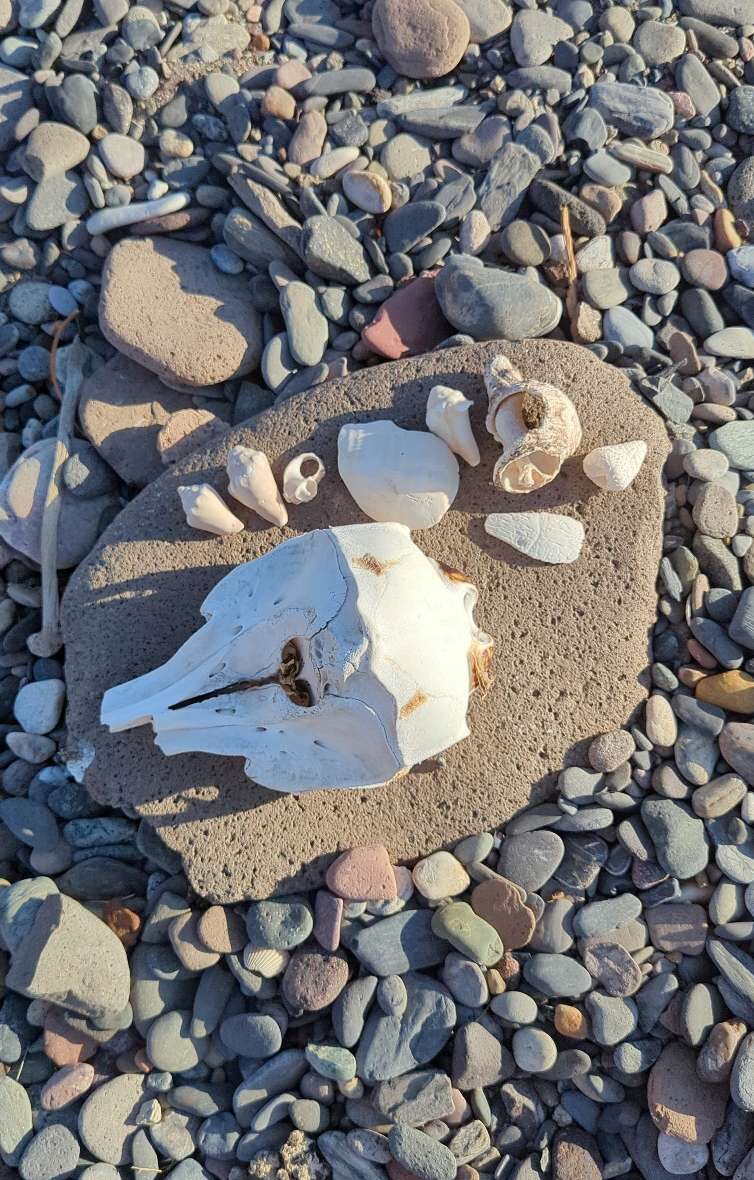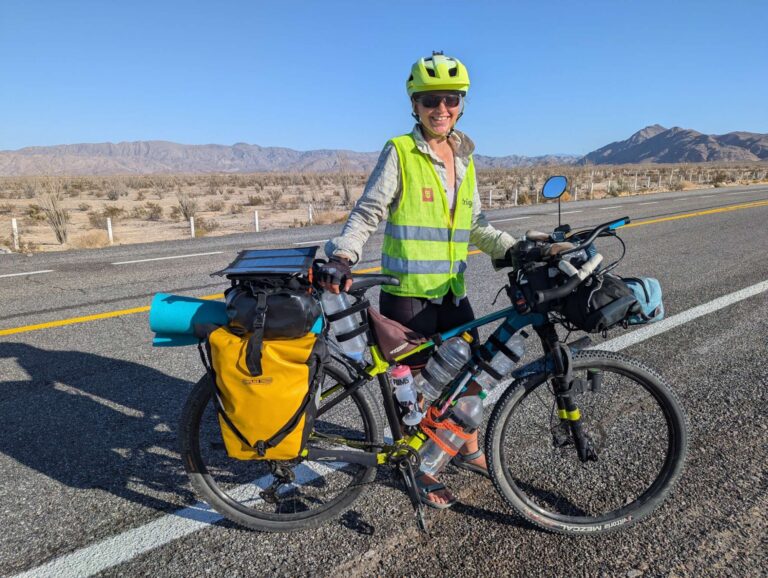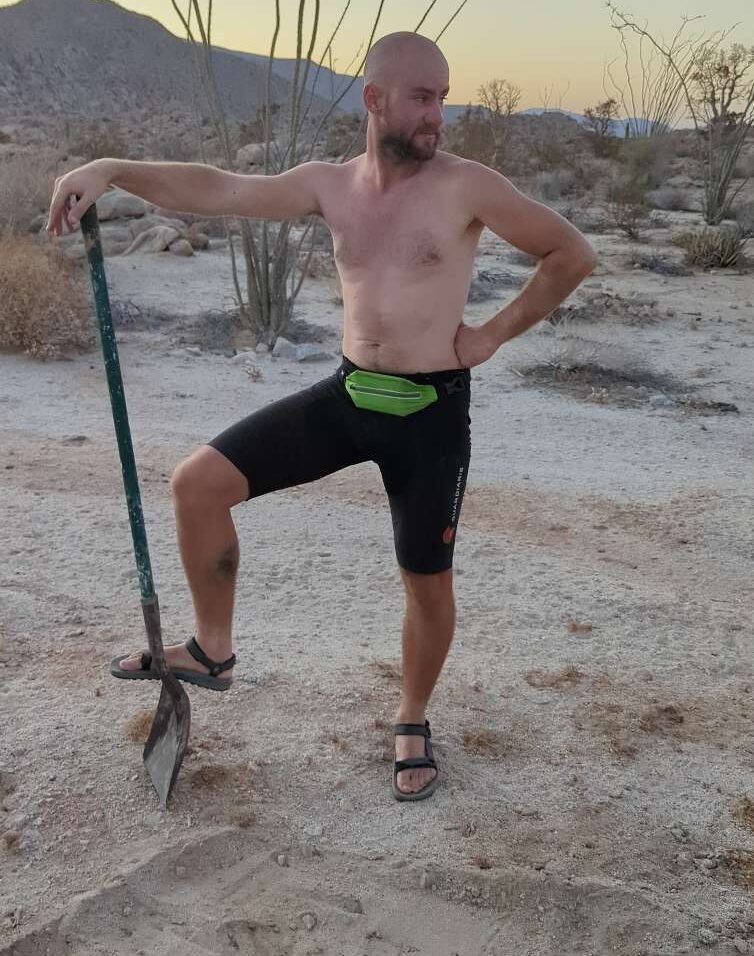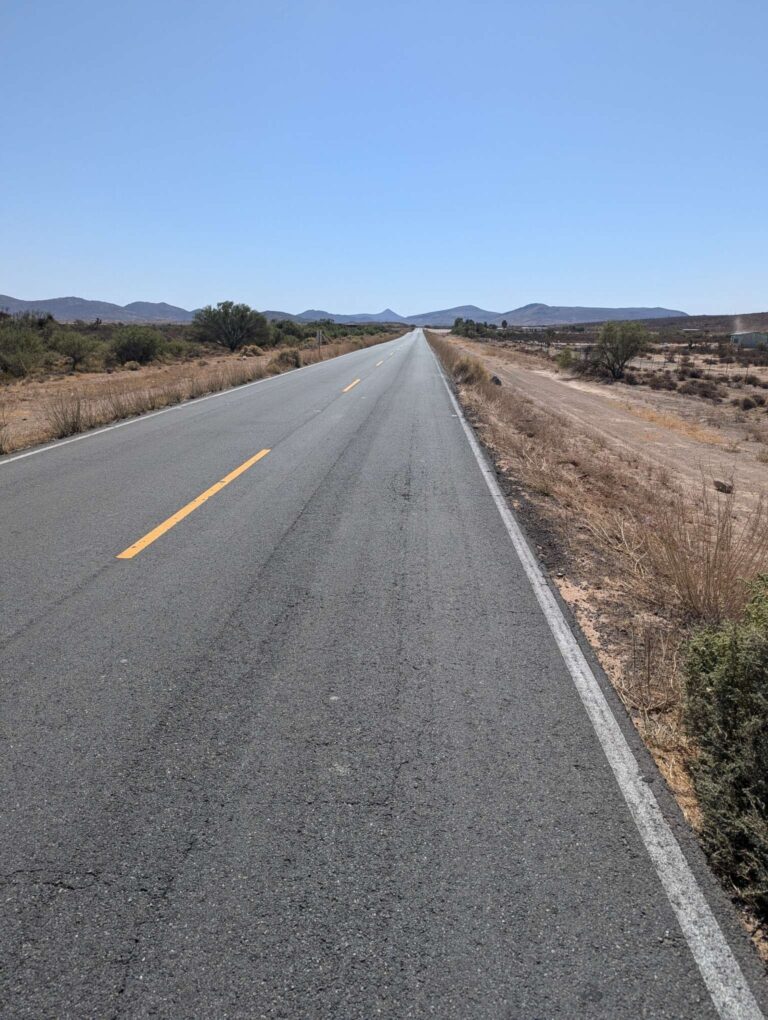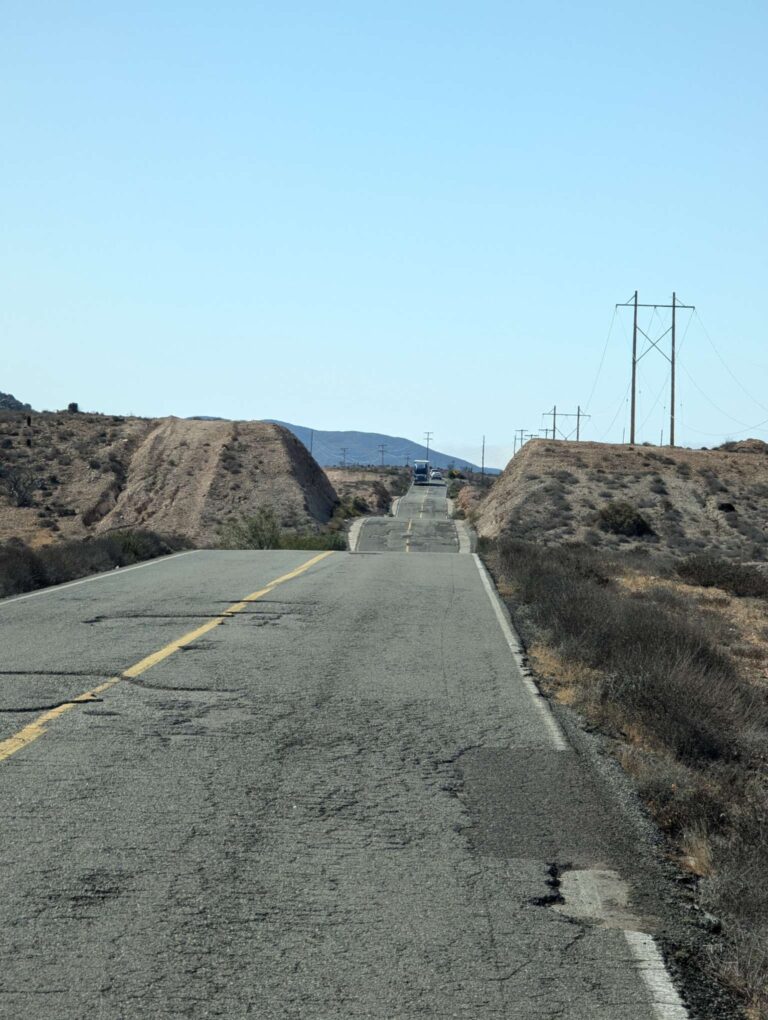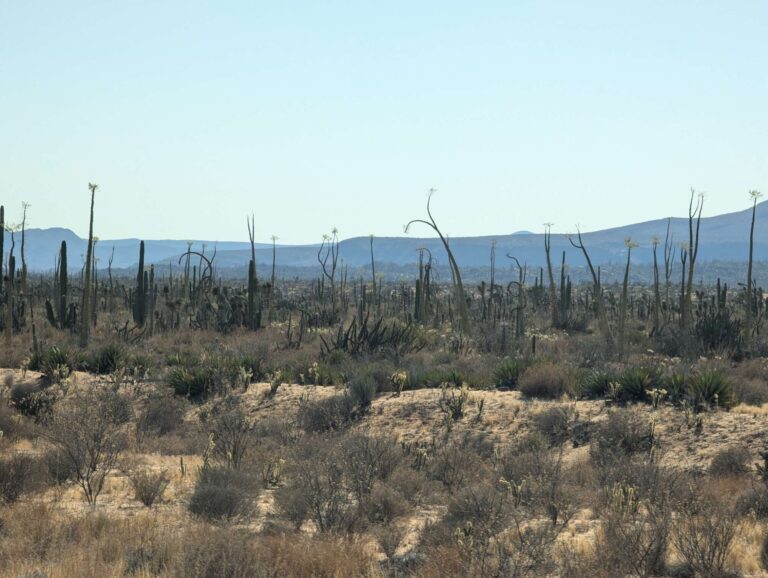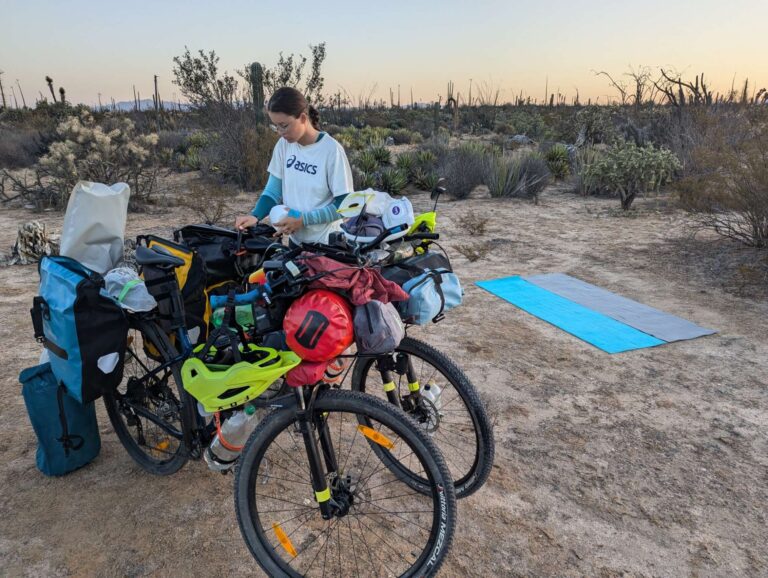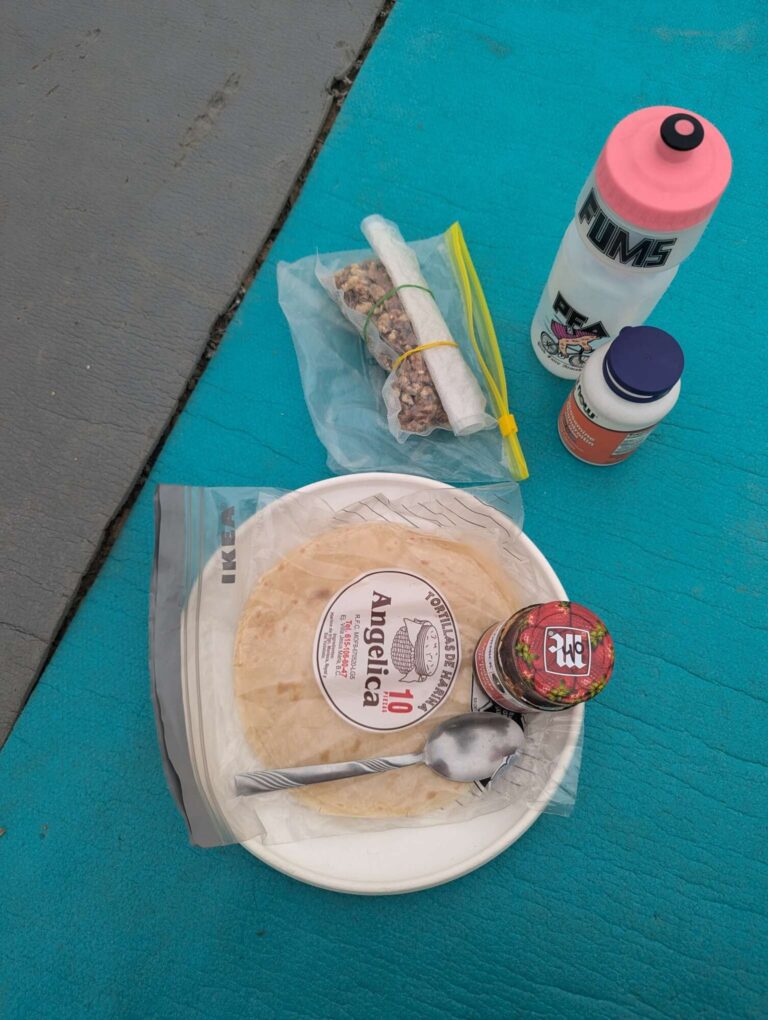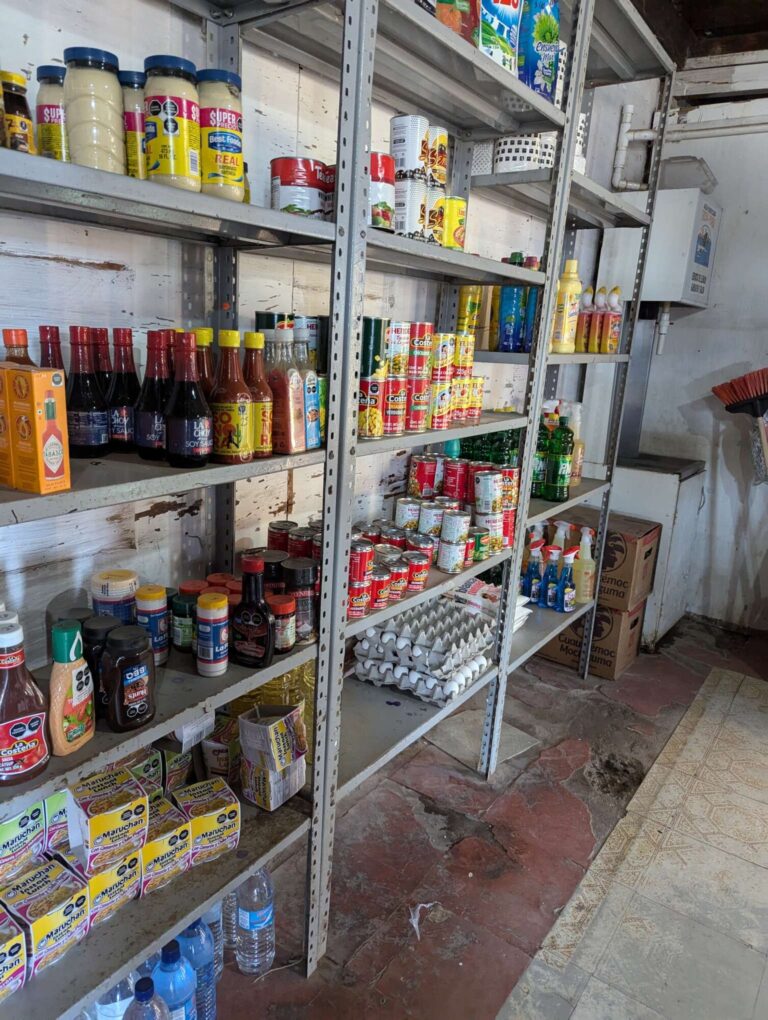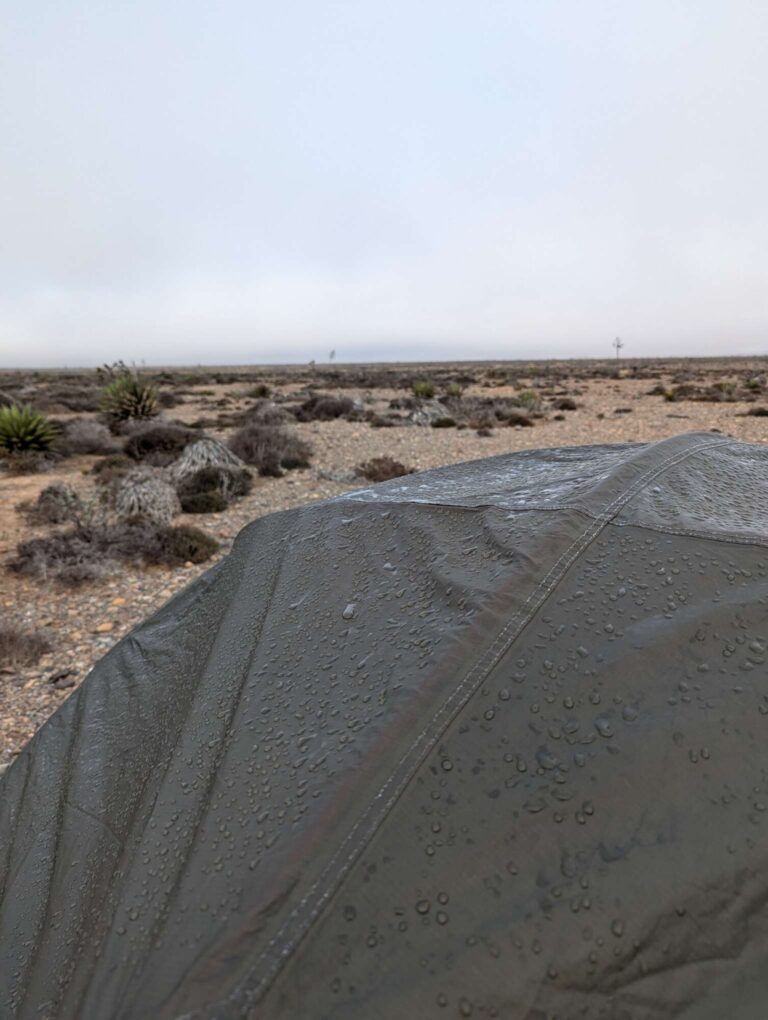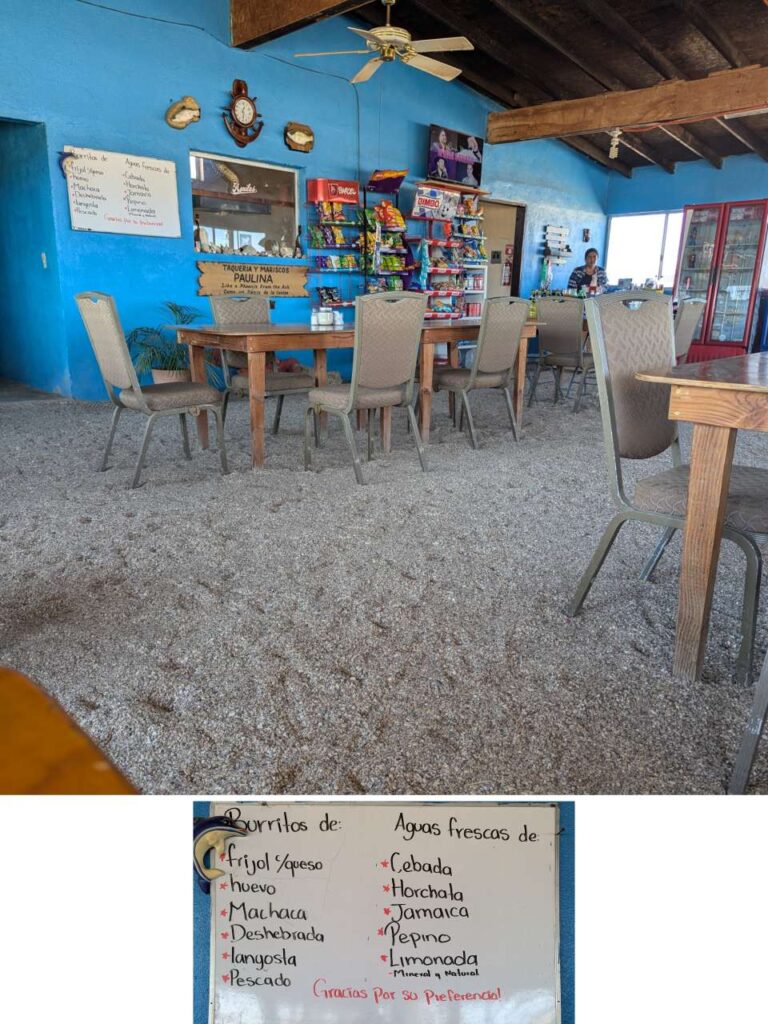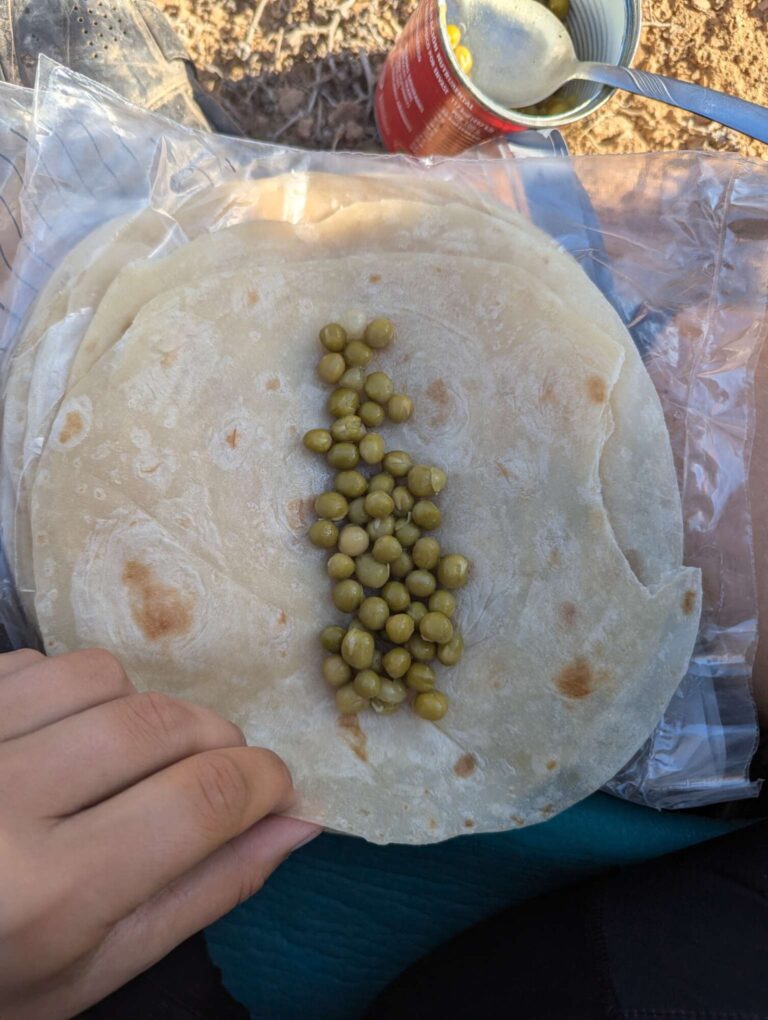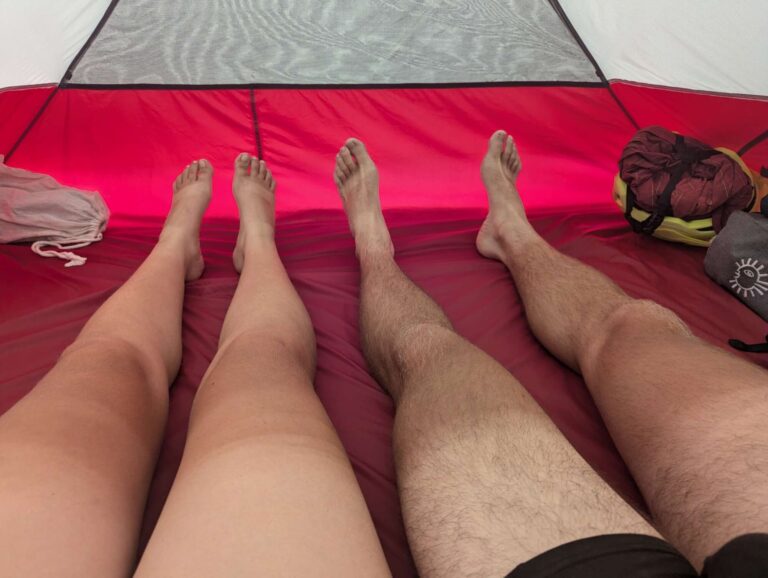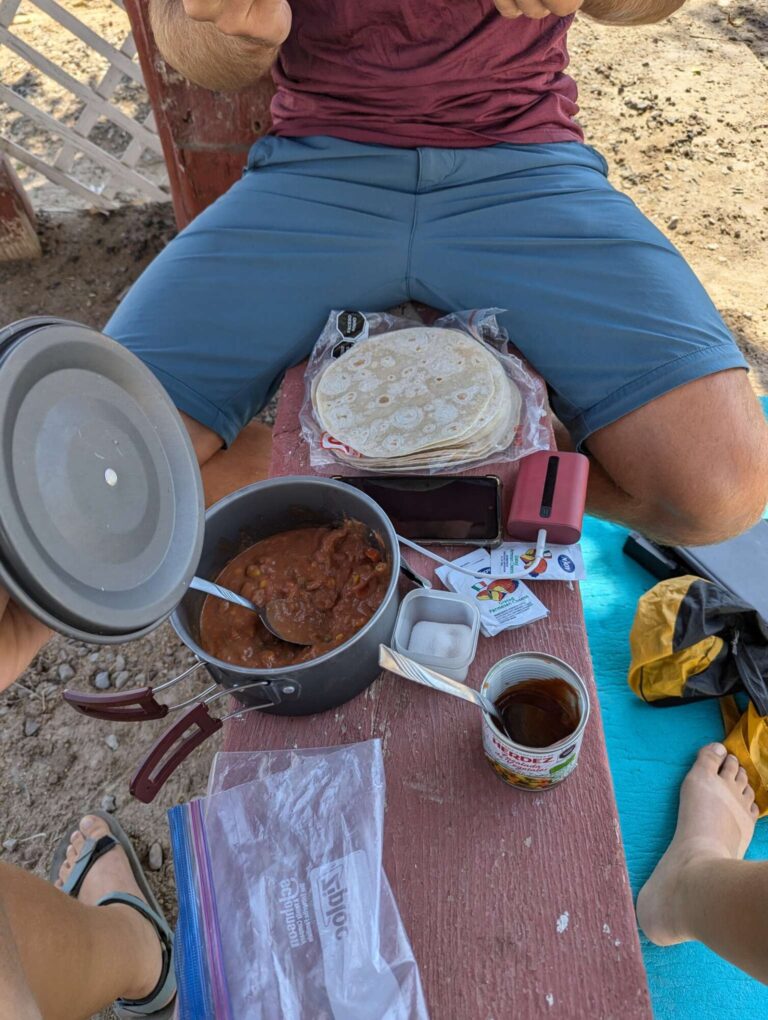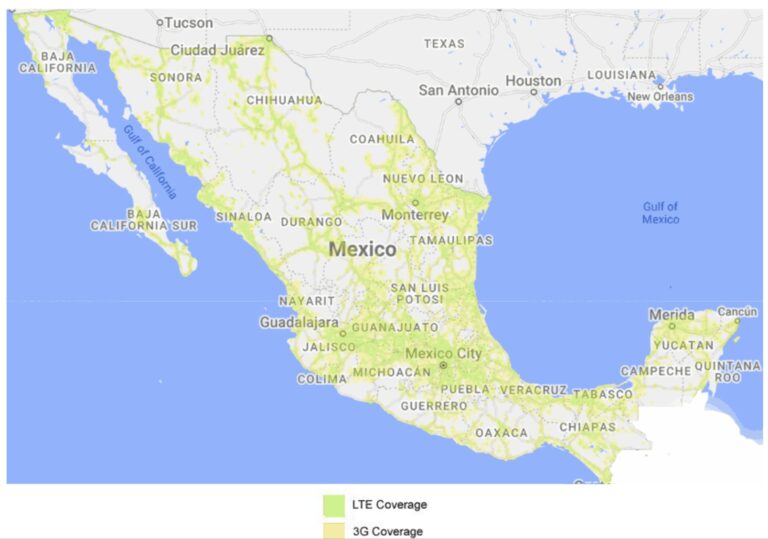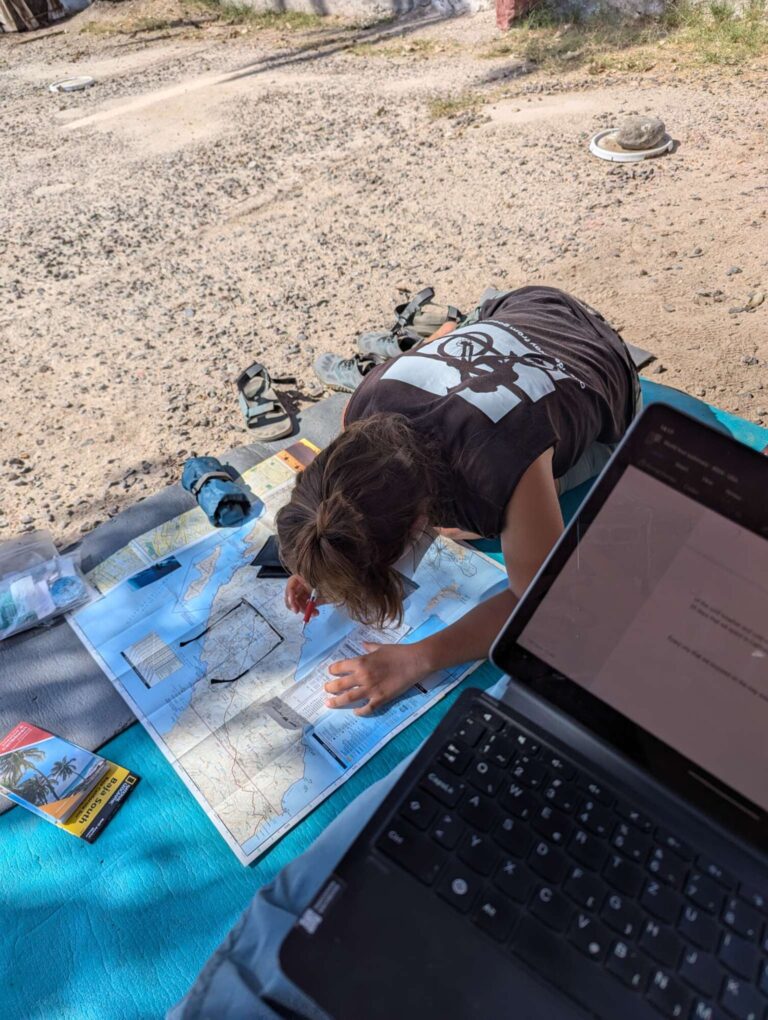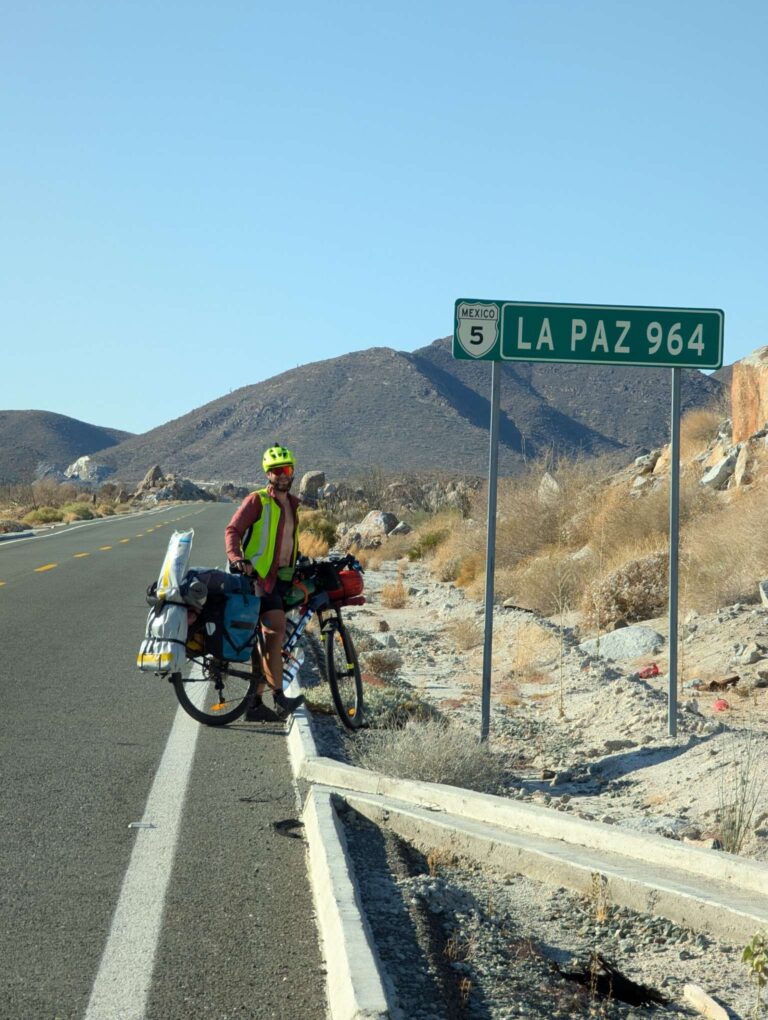Tuesday, 1 October, 2024 – Monday, 14 October, 2024
After two nights at Valery’s place in San Felipe, it was time for us to continue. We thanked Valery and Anna for their kindness, petted Elvis and Nelly, and said our goodbyes. There was one more thing to do before leaving San Felipe: we needed to restock on water and food. A quick visit to agua purificadora and Calimax, then we headed south. We bought some snacks in Calimax for the following day because it would be 100th, so we wanted to celebrate a little bit. Also, since we drink so much water and sweat a lot, we bought a bunch of electrolytes and rehydration powder to mix into our water bottles. It was around midday when we left San Felipe, but we felt well-rested, so we were cycling quite fast.
We don’t know exactly why, but it seems that a lot of times people drop huge piles of fish scraps or seashells next to the road in the desert, which stinks terribly as you pass them. It’s probably because of the almost nonexistent waste management that we’ve seen here. People are just used to throwing all of the garbage in nature. Every once in a while we also passed some decaying animals close to the road, like dead cows or horses, which don’t really improve the smell that you get from the piles of dead fish.
As we covered more ground south of San Felipe, we saw what we were excited about for a while: giant cactuses! They started to appear one by one in the distance, slowly getting more and more common until we reached the sign for “Valley of the Giants.” They advertise that there are some of the biggest cacti that you can see, so we naturally had to go and check them out. But sadly, the place closes at 4 PM and we arrived 20 minutes before closure, which is not nearly enough time to go inside and explore the area. The entrance fee is 200 pesos per person (around 10€), but that’s unfortunately all that we can tell you about the place. We took a lot of pictures of giant cacti, and as we continued, they started to grow more sparse again, so we thought that they might grow only in this area. But we were wrong; we will see A LOT of them in the future, and some of them will be extremely huge! We googled a little bit about these cactuses; apparently, they can grow up to 15 meters high, weigh up to 25 tons, and their age is counted in centuries.
That night was hot and damp again. It was the first time in Mexico that we didn’t cover our tent with the outer rain cover; we prioritized fresh air over being more hidden. The pattern we’ve seen in the east part of Baja is that as soon as it gets dark, the temperature and moisture in the air rise, and it takes around 2 to 3 hours to cool down again. It’s interesting because the air already cools down towards the evening, but you start to sweat again like crazy as soon as the sun disappears.
We’ve reached the milestone of 100 days on the road! We couldn’t find any cake in the store the day before, so we improvised a little bit with a few chocolate rolls, a couple of muffins, and one small chip. It was a pleasant start to the day, but there was more to come. We wanted to get a cold drink somewhere to celebrate, and we stopped after 45 kilometers at Cowpatty’s bar by the road, around kilometer 174 on Highway 5. Many people on iOverlander wrote that the bartender there is very nice and that you can ask to camp in the back, so we tried our luck. We were met with around 10 Americans that moved from the USA to Baja and the bartender Ted, who moved there from Ireland. Since it was around noon, we were surprised by the number of people in the bar, and then we were told that it was the first day that the bar reopened; it was closed during the summer because it was too hot and many people went back to the States. We were also told that we must be among the first cyclists through Baja for the season; most people recommend going between November and February, otherwise the desert is too hot. Anyway, the bar is for sure worth the stop; it has a special atmosphere that is a mixture of desert racing stickers and old road signs on the wall. Ted is extremely kind; he allowed us to set up a tent in the back, and he keeps the beer cold in the freezer. Besides the beer, you can get different drinks, but the only food they serve is hotdogs; based on the name of the place, we were expecting to get some beef burgers. Ted keeps a book of guests that he offers to all cyclists, and we found our friend Yors signed in there. Ted also loves to learn some words in different languages, and because we were the first Slovenians he had, we had the pleasure of teaching him some useful phrases, like “Welcome”, “Would you like a beer?”, and “You can camp behind the bar”.
It was nice to be able to freely speak with people in English again, and we took out our paper maps to mark down some recommendations that we got from other guests. One lady, Brandy, was also so kind that she bought Iris a Cowpatty’s tank top shirt. There was one more luxury: Ted offered us the outdoor shower.
On the following day, Thursday, day 101, we were the sweatiest we’ve been in Baja. A lot of ups and downs on the road. After 45 kilometers, we took a break on the wide paved shoulder with a beautiful view over the beach. We decided to go down to the water and camp there. The water was extremely warm, not refreshing at all. When it got dark (at around 7 PM), the temperature rose again; we got totally wet while setting up the tent. We used our frisbee for the next 15 minutes to make some wind and cool ourselves a little bit. The remainder of the night was still hot, but it became bearable around 2 hours after the sunset. We took a small risk by setting up a tent so close to the ocean because of the tide. When we got there, we marked the water level, and in the morning the water moved around 15 meters away from us. If it came towards us, we would wake up floating on our air mattresses.
We’re slowly building a habit of going early in the tent, where we watch a movie on our tablet before we go to sleep. We don’t want to risk driving on the highway when it gets dark, and the days are slowly shortening, so we get a lot more time to spend in the tent. We downloaded a few movies before we left Europe, but we’re slowly running out of them; we didn’t plan to watch them so often.
After 30 kilometers on day 102, we got to a small marketplace by the road, where we found a table in the shadow—our resting spot for the next few hours. We had plenty of work: buy groceries, eat breakfast, write a diary and blog, cook lunch, and buy more purified water. We paid 25 pesos (around 1,25€) for 16 liters of water. Speaking of water, we carry a lot of it on our bikes. We slowly increased the capacity, and now we can have up to 20 liters combined. It took us a lot of improvisation on where to put it and how to strap the water bottles, but we did it. And all that on the bikes that are not even meant for turing; they’re mountain bikes. So, why do we have so much water with us? There are a few reasons:
- We’re a bit early for the season, and the temperatures are still very high throughout the day.
- There can be up to 150 kilometers between the purificadoras or markets where you can get water.
- We love the freedom of staying somewhere if we like it, like the beach where we spent the last night. For this, we need to have enough water and food with us.
- We try not to be too dependent on people stopping on the road and helping us.
The connecting part of Highway 5 to Highway 1 was built quite recently; the road is smooth with wide shoulders, so it’s pleasant to ride on. Cycling there, we saw an older gravel road that we read about on different blogs, and we were expecting to ride on it for a few days. It goes zig-zag around the new highway, and we used one of the intersections to get off the highway and sleep close to the old road. We’re happy that we had the luxury of the new highway; the old gravel road looked beaten up and full of holes.
The nights were slowly getting fresher as we were going uphill and away from the East coast. On Saturday, day 103, we reached the end of Highway 5 and we joined back on the main Highway 1, which we will follow all the way south from now. Before the intersection, we had a backwind combined with a gentle descent, so we were cruizing at the speed of 35 km/h; we were like rockets! When we took the left turn on HW 1, the wind came in bursts from the side. This, combined with fast trucks passing us at close distances, made the driving very dangerous. On one occasion, Iris even drove off the road because of the truck wind pulling her under it. In general, Highway 1 isn’t as pleasant to cycle on as Highway 3 or 5 were. There isn’t any shoulder most of the time, the traffic is worse, and the road is narrower with potholes. But it’s the only road that you can use to go south; not much to choose from.
We reached the area that looked like a forest of cacti. The view over it from the top of the hill was amazing, and we set up a tent in the middle of it in the evening. We were curious about the hoofprints that we saw on the ground; our idea was that maybe there were some rangers on horses, occasionally patrolling around cactuses. We got the explanation in the morning of day 104 when we saw some horses from the road. We didn’t know if they were wild horses or if they just ran away from the ranch. We had another surprise the next night; we heard a donkey close to us while we were watching the Shrek movie.
We woke up on a cold Monday morning, day 105. The tent was completely soaked on the outside because of the fog and from the inside because of our breathing. Since we weren’t in a hurry, we took our time getting out of the tent, we ate breakfast standing next to the bikes, then we waited for the tent to dry in the sun. Our breakfast that morning was pathetic: we shared one tortilla with peanut butter and strawberry jam, then we ate a few walnuts on top. That was the only food we had left. To get the proper breakfast, we needed to cycle around 30 kilometers, having a lot of hills and descents on the way. When we finally reached that small market, we didn’t have much to choose from. We got one toast bread, 10 tortillas, a can of peas, and one jam, paying around 10€ for everything. We have no idea how the locals can afford these prices; almost everything is more expensive than it was in Europe.
We were slowly getting close to the west coast of the Baja again, so the temperatures were slowly dropping and the wind was becoming fresh once again. Because of that, we didn’t drink as much water through the day anymore—only around 2-3 liters per person instead of around 5 liters that we drank on the east side. That evening we camped around 3 kilometers away from the Pacific Ocean. Far enough from the road, so we were hidden, but anything closer to the ocean and we would have a lot of fog from the afternoon to the late morning the next day. We saw our first scorpion that evening, just as we were getting into our tent. It wasn’t big, only around 1 cm in size, but we couldn’t risk it getting into our shoes, so we sadly had to remove it.
Even wetter morning on day 106, the fog was very dense, and our tent looked as if there was heavy rain all night. We cycled 20 kilometers to a small village—a gas station and two tiny restaurants. We stopped at one and got frijoles con queso burrito (burrito with beans and cheese), and horchata, which is a drink made of rice milk with cinnamon and different spices. The main reason we stopped there: they had wifi so we could update our Instagram. We had a very flat day with a straight road; there weren’t any curves or hills. The riding was easy, but hiding in the evening was a bigger challenge than usual. There wasn’t anything we could hide behind, so we just cycled a bit away from the road, setting up a tent behind a small bush to get at least some coverage. We had the worst dinner on our journey: tortillas with peas. That’s it. Naturally, neither of us was very satisfied with that, so we decided to also eat tomorrow’s breakfast. We couldn’t wait for the next day because we would reach a bigger town, Guerrero Negro. There we will be able to restock our food.
It’s been almost a week without a shower again, so let us tell you how we keep at least some level of cleanliness. We don’t know what we would do without the wet wipes; each evening we use a few of them each to wipe our faces, armpits, privates, and feet. We feel like this is the bare necessity. If we have a strong desire to “properly shower”, we have a small towel that we can wet and use to wipe ourselves. Then, we try to plan to stay in a camp approximately once a week and shower there. For anyone more concerned with his personal hygiene, there are some places by the road where you can take a shower for around 1 to 3 euros, usually next to some restaurants or gas stations. But wet wipes work for us, so we didn’t try them out yet. But we do miss Europe, where we could find a few drinking fountains every day, which made the showering process much easier. We were willing to pay the price of a few weird looks for stripping down to our underwear and taking a “shower” there.
We’re slowly learning how spoiled we are in Europe. Having running water and electricity everywhere, you can drink almost any water you find, and you need to put in effort to even find a bad phone reception. Our homes have AC, hot showers, and drinkable running water without a question. Here, most houses have cisterns with a limited amount of water; toilets here use way less water to wash down; people have to buy the water to drink in purificadoras; and most of the cars wouldn’t go over the vehicle inspection process in Europe. Over half of our time spent in Baja, we didn’t have a phone reception.
The Baja Peninsula is separated into two Mexican states: Baja California on the northern half and Baja California Sur on the southern half. It took us 17 days, and on Wednesday, day 107, we crossed over the border into Baja California Sur. Right after the border crossing, which is just another military security check, we finally reached the town of Guerrero Negro. Did we have any problems with this security check? No, because we somehow completely missed it. There was a sign for cars and trucks to keep on the right road, but it said “military zone,” and we didn’t want to accidentally be somewhere where we weren’t allowed, so we turned around and took the left road. After 200 meters, we figured out that it was a one-way road in the opposite direction, which completely avoided the military checkpoint. As typical tourists, we just pretended that we didn’t see the signs and continued.
The town of Guerrero Negro is a popular touristic spot for whale-watching tours, which take place in months from December to March. But outside of the season, the town is dead. There were 2 hotels and 1 campground opened, so we didn’t have much choice where to go. The northern part of the town is composed of mainly small houses and huts, looking extremely poor. There is one main road into the town, and everything touristic is located on that street. The camp where we stayed was more of an overnight RV parking combined with a restaurant, but it still looked like the nicest and safest place from the main street. But before we stopped there, we had to visit a laundry place, where we again paid around 4€ for washing and drying our dirty clothes. And we finally got to a big supermarket called Ley’s to get some decent food.
We were the only guests in the camp. Was there anyone working in the reception? Sure, it was the same guy who was also a bartender and a waiter (and maybe even a cook?). They charged 200 pesos per night (around 10€) and were not willing to give any discount for a multiple-night stay. We planned to stay in the camp for a few nights, catch up on our blog and Instagram, and do some much-needed planning for the future. Because of that, we decided to pay for 2 nights, then we would buy extra if we needed. The sky was the limit when we were deciding where to set up our tent in that parking lot. We picked the parking spot with the most shadow and a small bench next to it—in other words, we got a premium pitch. Many years ago, someone decided that it would be a good idea to put a water pipe right next to the electricity outlets in every parking spot, and it has remained this way ever since. The reviews on the iOverlander application about this place were all positive; a few of them said the toilets are clean and the shower is hot. Well, maybe it really is so in the middle of the season, but we had a different experience. There was one toilet unlocked, and it didn’t flush at all. And the only unlocked shower was dirty and didn’t even have warm water, let alone a hot one. But we still had a good time, and we managed to get two nights extra (nobody was there to charge us), so we felt it was a fair deal at the end.
But we weren’t the only guests for a long time—almost every evening, there would be one to three RVs that would park in there and leave in the morning. We talked with some of them; most noticeably, we met Mark, who was kind enough to lend us his super-comfortable chairs for the evening. But we had the place to ourselves for the day; nobody else stayed for more than one night.
We took advantage of the electricity and semi-fast wifi—we had videocalls with our families, watched movies in the evenings, and most importantly, we spent a lot of time reading blog posts about the road ahead and planning what we would do when we would cross from the Baja Peninsula to the mainland Mexico. More about our plans for the future will be available in some later post; we’re not fixed on anything yet and the current plans already change weekly because of the changing conditions in Mexico.
The weather we had was weird—evenings and nights were very cold, there was fog in the morning until around 10 AM, and the days were hot in the sun and cold in the shadows. There were two extremes: we would be wearing short sleeves and sweating in the sun, then we would go in the shadow and would have to put on our fleece jackets. In general, the air was cold because of the Pacific Ocean, and the sun was very strong—perfect weather to get sunburns without knowing.
On Friday evening, day 109, we heard some loud noises that we first thought were fireworks, but we quickly realized that what we heard were gunshots. The sound came from the northern part of the town, and we were extremely happy that there was a high wall all around the campground. We heard around 30 shots, but luckily they were getting quieter—they were moving away from us. We figured out that if it was something serious, we would hear some screaming noises, but everything else seemed quiet. We had no idea what was going on; maybe someone just practiced shooting, but if nothing else, this made us realize how little we know about Mexico and how easy it is to be in the wrong place at the wrong time.
Altogether, we stayed there for 6 nights, arriving on day 107 and leaving on the morning of day 113.
We couldn’t predict it, but there was a disaster waiting for us the following morning. We carry tools and spare parts to fix most of the common equipment and bike malfunctions, and luckily, we also had what we needed for this one. We didn’t go cheap with our MSR Elixir 3 tent because it was supposed to be our home for over a year; the spare part was more of a “just in case” that we took with us, but now we needed it. Anyway, our tent pole broke on its own, there wasn’t any wind, and the tent was standing normally in the same spot for the last 6 nights. But when we took the rain cover off the tent the following morning, we heard a loud cracking sound: our tent pole. Now we will contact MSR and the store where we bought it and check if we can use the warranty that they offer. Fingers crossed!
Some more pictures:










